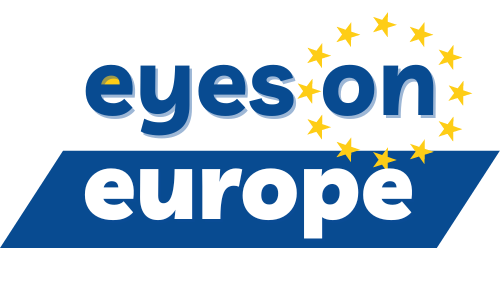The Effects of US Tariffs on Europe: An Uncertain Future for Transatlantic Relations
17 April 2025 /
Sara BORDIGATO 7 min

The economic relationship between the EU and the US is often described as the most significant bilateral trade partnership in the world. Together, they account for slightly a bit less than half of the global GDP and a third of the total world trade. But this long-standing partnership now faces growing tensions. As trade barriers rise, fears grow about the future of economic cooperation between the two global giants. This article explores how US tariffs are affecting Europe, what could happen next, and why the stakes are so high.
What Are Tariffs, and Why Do They Matter?
Tariffs are taxes imposed by a government on goods imported from other countries. For example, if the United States (US) government places a 20% tariff on European cars, then every car imported from Europe becomes 20% more expensive for American buyers. The idea behind tariffs is often to protect domestic industries by making foreign goods more expensive and less competitive. In reality, tariffs can trigger retaliatory actions, increase consumer prices, strain diplomatic relationships, and disrupt global supply chains.
On the day President Trump announced the new tariffs, a baseline rate of 10% was applied to every country listed in the graphic, with the European Union treated as a single country.
| COUNTRY | Tariff charged to the US (according to Trump’s calculations) | US discounted reciprocal Tariffs |
| China | 67% | 34% |
| European Union | 39% | 20% |
| Vietnam | 90% | 46% |
| Taiwan | 64% | 32% |
| Laos | 95% | 48% |
| Switzerland | 61% | 31% |
| United Kingdom | 10% | 10% |
| India | 52% | 26% |
| South Africa | 60% | 30% |
| Israel | 33% | 17% |
The first column shows the amount of tariff charged on the US by the country. For example, in the case of China, 67% is the amount of tariffs the US are currently on by China: to be fair, they should have added to the tariff rates the non tariff barriers. However, the calculation made was taking the trade deficit (so the difference between exports and imports within a given country) and dividing it to the county’s export to the United States. The second column is that value divided by half, so the tariff that the US is posing as a consequence on the given country. As stated before, the baseline is 10 for everyone. This means that those smaller states, like Laos that imports way more than what they export to the United States, and this has made Trump say that Laos has put 95% of tariffs on the US, so it will now have a 48% tariff on its goods.
Current Impact of US Tariffs on Europe
In recent years, the US has shifted towards a more protectionist trade policy, focused on shielding domestic industries from foreign competition. This shift reached a critical point with the announcement of broad and unprecedented tariffs targeting countries around the globe, including key US allies.
The EU was hit particularly hard, as the US has been imposing tariffs on steel and aluminium, and later on cars and automotive parts, which are major European exports. In response, the European Commission introduced countermeasures on a range of American goods. Despite these efforts, Europe is already feeling the effects. According to European Commission President Ursula von der Leyen, the US tariffs are “brutal and unfounded” and risk seriously harming both economies. She further warned of disastrous consequences for millions of workers and businesses on both sides of the Atlantic.
What Could Happen Next
Things took a dramatic turn with the announcement of 20% tariffs on nearly all EU exports to the US. President Trump celebrated this move as “liberation day,” suggesting it was a victory for American independence from foreign competition. For European exporters, it marked a potential economic disaster. Nearly 70% of EU exports to the US, valued at around €380 billion, could be affected. These include key products like cars, machinery, chemicals, pharmaceuticals, and luxury goods.
Economists predict that, even if trade volumes remained stable, these tariffs could generate up to €80 billion in revenue for the US government. However, this is unlikely. Higher costs usually mean lower demand, so many European products might become too expensive for American consumers. Some studies suggest that EU exports to the US could fall by up to 50%, especially in price-sensitive sectors like agriculture and manufacturing. The domino effect could lead to factory slowdowns, job cuts, and lost income across Europe, especially in export-heavy countries like Germany, France, and Italy.
Europe’s Strategic Response: Walking a Tightrope
The EU’s response to this escalating trade dispute has been measured but firm. President von der Leyen stated that Europe feels let down by its oldest ally but emphasized the importance of avoiding a full-scale trade war. The EU faces a tough challenge: appearing strong and united while avoiding actions that could provoke even harsher US retaliation.
One option under consideration is imposing symbolic tariffs on iconic American goods such as Orange juice from Florida, jeans from Levi’s or Whiskey, touching emotional products from key geographical areas of the US. These products are chosen strategically, not just for their economic value but for their political visibility. Targeting them sends a message, especially in swing states, where elections can be influenced by economic backlash.
However, some EU countries are urging caution. France, Italy, and Ireland have pushed to exclude bourbon whiskey from the retaliatory list. They fear the US could respond with extreme tariffs up to 200% on European wines and spirits, which are key export products for them. This highlights a core challenge for the EU: balancing national interests with collective action.
Where Do EU-US Relations Go From Here?
Beyond tariffs, the EU could take more targeted actions. One significant pressure point is the US services trade surplus with the EU, which totals around €109 billion. In other words, the US earns far more from exporting services (such as finance, tech, and consulting) to Europe than it spends on importing services from Europe. If needed, the EU could restrict US access to public procurement contracts (like government projects and infrastructure), European financial markets, and digital and tech sectors, where American companies like Google, Amazon, and Microsoft dominate the whole industry. These measures could have serious consequences for US businesses and might encourage American policymakers to return to the negotiating table.
Key Challenges Ahead for Europe
In this evolving landscape, the EU must confront serious challenges, like maintaining unity among member states by crafting a common strategy that requires alignment among 27 countries with different economies and political priorities. It is key to balance economic impact with political pressure, as retaliation must be strong enough to send a message but not so damaging that it hurts European workers and industries. The EU champions rules-based trade under institutions like the World Trade Organization (WTO), while the US’ unilateralism threatens to undermine these global norms. It is fundamental now for Europe to be the one to lead by bringing unity and pushing other states to act more in sync.
In the face of uncertainty, Europe may need to deepen ties with partners like Canada, Japan, India, and emerging markets to reduce its dependence on the US and, create alternative routes, and substitute American goods with new frontiers.
A Turning Point in Transatlantic Trade
The tariffs imposed by the US mark more than just a policy shift but represent a stress test for the entire transatlantic relationship. While the EU has responded with restraint and strategic thinking, the path forward is far from clear.
Can the EU present a united front? Will the US reverse course or double down? Can both sides avoid a deeper conflict and instead return to cooperation? The answers to these questions will shape not only the future of EU-US trade, but also the health of the global economy in the years to come. The stakes are high, the road is uncertain, but one thing is clear: how both sides respond now could define a generation of transatlantic relations.
Sara Bordigato is a Master student at the Université Libre de Bruxelles
